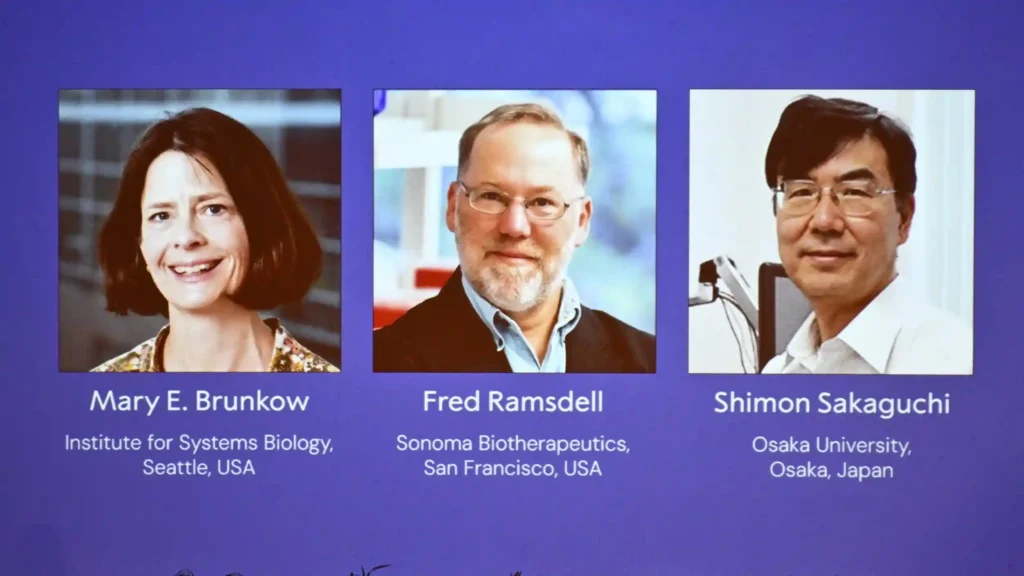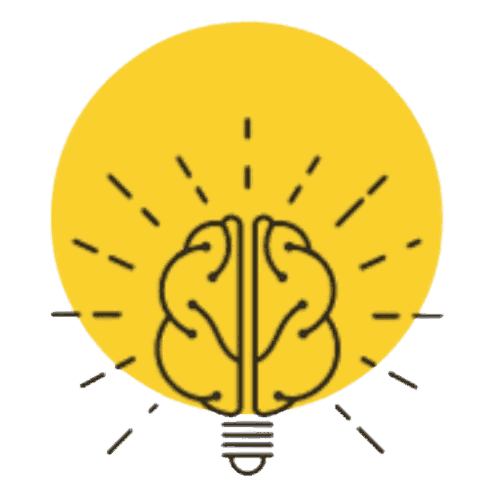New Delhi: In a landmark moment for medical science, the 2025 Nobel Prize in Physiology or Medicine has been bestowed upon three pioneering researchers: Mary E. Brunkow and Fred Ramsdell from the United States, along with Shimon Sakaguchi from Japan. Their collective work has revolutionized our comprehension of peripheral immune tolerance, a critical mechanism that helps the body distinguish between harmful invaders and its own tissues. This prestigious award, announced on October 6, 2025, highlights the profound impact of their findings on immunology and opens new avenues for treating diseases like cancer, autoimmune disorders, and improving organ transplant outcomes.

Laureates Mary E. Brunkow, Fred Ramsdell, and Shimon Sakaguchi, recipients of the 2025 Nobel Prize in Physiology or Medicine.
The announcement came from the Nobel Assembly at the Karolinska Institute in Stockholm, marking the kickoff to the 2025 Nobel Prize series. As shared on the official Nobel Prize X handle (@NobelPrize), “The 2025 #NobelPrize in Physiology or Medicine has been awarded to Mary E. Brunkow, Fred Ramsdell and Shimon Sakaguchi.” The trio will equally divide the prize amount of 11 million Swedish kronor, equivalent to approximately $1.2 million. This recognition not only celebrates their individual contributions but also underscores the collaborative nature of scientific progress in unraveling the complexities of the human immune system.
The Announcement and Its Context
On October 6, 2025, at 03:51 PM IST, the world learned of this year’s Nobel Prize in medicine winners through various media outlets, including updates from Livemint. The panel at the Karolinska Institute delivered the news, emphasizing the laureates’ role in advancing knowledge about how the immune system maintains balance. This award is the first in the 2025 lineup, with subsequent prizes in other categories scheduled throughout the week. For those tracking the full schedule, the Nobel announcements span from October 6 onward, covering fields like physics, chemistry, literature, peace, and economics.
The official post on X from @NobelPrize featured portraits of the winners, arranged left to right as Mary E. Brunkow, Fred Ramsdell, and Shimon Sakaguchi. This visual representation, sourced from the Nobel Prize account, captured the essence of their achievement and quickly went viral among science enthusiasts and the general public. The prize money, a substantial 11 million Swedish kronor, reflects the high value placed on such transformative research, translating to nearly $1.2 million in U.S. dollars for the shared honor.
Amid broader discussions in the news, unrelated claims like former President Trump’s assertion that he deserved a Nobel for “ending seven wars” provided a contrasting backdrop, but the focus remained squarely on the scientific merits of the medicine prize. Additionally, recent reports linking COVID-19 to increased risks of autoimmune diseases have made this award particularly timely, as it directly relates to understanding and combating such conditions.
Profiles of the 2025 Nobel Laureates in Medicine
Mary E. Brunkow, aged 64, currently serves as a senior program manager at the Institute for Systems Biology in Seattle, USA. Her expertise in systems biology has been instrumental in bridging genetic research with immunological applications. Brunkow’s journey in science has positioned her as a key figure in exploring how genetic factors influence immune responses, particularly in models of autoimmune diseases.
Fred Ramsdell, also 64, holds the position of scientific adviser at Sonoma Biotherapeutics in San Francisco, USA. His advisory role involves guiding the development of biotherapeutic solutions, drawing from his deep knowledge of immune regulation. Ramsdell’s work has often focused on translational aspects, turning basic discoveries into potential therapies that could benefit patients worldwide.
Shimon Sakaguchi, at 74, is a distinguished professor at the Immunology Frontier Research Center at Osaka University in Japan. As a veteran in the field of immunology, Sakaguchi’s career has been defined by groundbreaking insights into T-cell functions. His professorship at this leading research center continues to inspire new generations of scientists in Japan and beyond.
These profiles highlight the diverse yet interconnected paths of the laureates. Brunkow and Ramsdell, both American researchers in their mid-60s, bring perspectives from biotechnology and systems biology hubs on the West Coast. Sakaguchi, the elder statesman from Japan, adds an international dimension, showcasing how global collaboration drives medical advancements.
Understanding Peripheral Immune Tolerance: The Core of Their Discoveries
At the heart of the 2025 Nobel Prize in Physiology or Medicine is the concept of peripheral immune tolerance. This process is a vital safeguard in the body’s immune system, ensuring it attacks foreign pathogens while sparing healthy self-tissues. Without effective tolerance mechanisms, the immune system could turn against the body, leading to autoimmune diseases. The laureates’ work has illuminated how this balance is achieved outside the central immune organs, in what is known as the peripheral immune system.
The peripheral immune system encompasses all immune components beyond the brain and spinal cord, which form the central nervous system. This includes circulating immune cells and responses in organs like the lymph nodes, spleen, and bloodstream. Grasping the intricacies of this system is crucial for deciphering how the body decides what to attack and what to protect. The research honored by the Nobel Prize focuses precisely on these decision-making processes, revealing mechanisms that prevent self-destruction while mounting defenses against threats.
A pivotal element in their discoveries is the role of regulatory T-cells, or Treg cells. T-cells, in general, are specialized immune warriors that protect the body from pathogens such as viruses and bacteria. They come in various subtypes, distinguished by unique proteins on their surfaces that dictate their functions. In 1995, Shimon Sakaguchi identified a novel subset: regulatory T-cells. These cells act as peacekeepers, dampening overactive immune responses to avoid attacking the host’s own cells—a phenomenon termed peripheral tolerance.
Building on this, Mary E. Brunkow and Fred Ramsdell delved into genetic underpinnings using animal models. They studied scurfy mice, which suffer from severe autoimmune conditions due to uncontrolled immune attacks. In 2001, their research pinpointed the FOXP3 gene as the culprit behind these issues in mice, and they linked it to the human condition known as IPEX syndrome, a rare but devastating autoimmune disorder.
This genetic breakthrough allowed Sakaguchi to connect the dots further. By demonstrating that the FOXP3 gene governs the development and function of regulatory T-cells, he solidified the understanding that defects in this gene lead to tolerance breakdowns. In 2003, Sakaguchi’s follow-up work integrated these findings, showing how FOXP3 acts as a master regulator for Treg cells, ensuring they properly suppress harmful immune overreactions.
The timeline of these discoveries—starting with Sakaguchi’s 1995 identification, followed by Brunkow and Ramsdell’s 2001 gene discovery, and culminating in the 2003 linkage—illustrates a progressive unveiling of peripheral tolerance. As noted by the Nobel Assembly in their release, “The laureates’ discoveries launched the field of peripheral tolerance, spurring the development of medical treatments for cancer and autoimmune diseases.”
The Scientific Breakthroughs in Detail
Diving deeper into the key highlights, the research primarily targets the peripheral immune system. This system operates independently of the central nervous system, handling immune surveillance in the body’s outskirts. Its importance lies in maintaining equilibrium: too aggressive, and it causes autoimmunity; too passive, and infections run rampant.
The discovery of Treg cells by Sakaguchi in 1995 was a game-changer. Prior to this, T-cells were mainly viewed as attackers, but regulatory variants introduced the idea of internal checks and balances. These cells “calm” the immune system, preventing misguided assaults on healthy tissues. Peripheral tolerance, as this mechanism is called, is essential for long-term health.
Brunkow and Ramsdell’s contribution involved meticulous studies on scurfy mice, models exhibiting rampant autoimmunity. Their 2001 identification of the FOXP3 gene revealed it as a critical switch for immune regulation. In mice lacking functional FOXP3, Treg cells fail to develop properly, leading to chaos. Extending this to humans, they connected it to IPEX, where similar genetic mutations cause life-threatening immune dysregulation.
Sakaguchi’s subsequent experiments confirmed FOXP3’s control over Treg development, providing a unified framework. This integration not only explained autoimmune origins but also paved the way for targeted interventions.
Implications for Medicine: From Cancer to Transplants
The significance of these discoveries extends far beyond theory, influencing practical medical applications. In cancer therapies, tumors often hijack regulatory T-cells to shield themselves from immune detection. By recruiting Tregs, cancers create a tolerant environment, evading destruction. Immunotherapies now aim to block this Treg activity, unleashing the immune system to attack tumors more effectively. This approach has led to innovative treatments that enhance anti-cancer responses.
For autoimmune diseases and organ transplants, the focus is on boosting Treg functions. Clinical trials are exploring ways to promote Treg formation, potentially halting autoimmune attacks or reducing rejection in transplant patients. These therapies could transform care for conditions like rheumatoid arthritis, multiple sclerosis, or post-transplant complications.
The Nobel Assembly highlighted that “this may also lead to more successful transplantations. Several of these treatments are now undergoing clinical trials.” Such advancements promise a future where immune-related diseases are managed more precisely, minimizing side effects and improving patient outcomes.
The Nobel Ceremony and Legacy of Alfred Nobel
The formal award ceremony is set for December 10, 2025, coinciding with the anniversary of Alfred Nobel’s death. Nobel, a prominent Swedish industrialist and the inventor of dynamite, passed away in 1896. His will established the prizes to honor those who confer the greatest benefit to humankind in various fields. This tradition continues, with the medicine prize administered by the Karolinska Institute.
In summary, the 2025 Nobel Prize in Physiology or Medicine celebrates a trio whose work on peripheral immune tolerance has ignited a new era in immunology. From Sakaguchi’s initial Treg discovery to the FOXP3 revelations by Brunkow and Ramsdell, their contributions have covered every facet of this vital field, promising breakthroughs in cancer, autoimmunity, and beyond. As the world reflects on this achievement, it serves as a reminder of science’s power to heal and protect.


A highly detailed article, making every aspect clear and interesting . Thank you